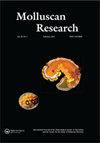Disentangling the impact of artificial substrata on the trophic ecology of the highly endangered marine invertebrate Patella ferruginea Gmelin, 1791
IF 0.6
4区 生物学
Q3 ZOOLOGY
引用次数: 3
Abstract
ABSTRACT Limpets are keystone species worldwide, promoting marine biodiversity in coastal areas. Of special concern are the so-called giant limpets such as Patella ferruginea, either due to their role in marine ecosystems and/or threatened status. The proliferation of artificial substrata caused by human population growth has allowed their use as a surrogate habitat for many species of limpets. However, little is known about the impact on the trophic ecology of these species caused by artificial substrata. The stable isotope approach has been widely used to explore the trophic ecology of marine species and so was used in the present study of P. ferruginea. The results of this study indicated that diet consumption differs between artificial and natural substrata for P. ferruginea. Enrichment in δ15N values of specimens collected within the harbour of Ceuta indicates that this endangered species would be a useful indicator for detecting anthropogenically derived organic matter in coastal areas. Further research is required to evaluate the impact of artificial substrata from a conservational perspective.人工基质对高度濒危海洋无脊椎动物Patella ferroginea Gmelin营养生态影响的研究,1791
帽贝是世界范围内的重要物种,促进了沿海地区的海洋生物多样性。特别值得关注的是所谓的巨型帽贝,如铁盔帽贝,因为它们在海洋生态系统中的作用和/或受到威胁的地位。由于人口增长造成的人造基质的增殖,使它们成为许多帽贝物种的替代栖息地。然而,人工基质对这些物种营养生态的影响尚不清楚。稳定同位素方法已被广泛应用于海洋物种的营养生态学研究,因此在本研究中被用于铁藻的研究。本研究结果表明,人工基质与天然基质对铁铁假单胞菌的食用量存在差异。在休达港内采集的标本δ15N值的富集表明,这种濒危物种将成为检测沿海地区人为来源的有机物的有用指标。需要进一步的研究,从保育的角度评估人工基质的影响。
本文章由计算机程序翻译,如有差异,请以英文原文为准。
求助全文
约1分钟内获得全文
求助全文
来源期刊

Molluscan Research
生物-动物学
CiteScore
1.80
自引率
10.00%
发文量
27
审稿时长
>12 weeks
期刊介绍:
Molluscan Research is an international journal for the publication of authoritative papers and review articles on all aspects of molluscan research, including biology, systematics, morphology, physiology, ecology, conservation, biogeography, genetics, molecular biology and palaeontology.
While the scope of the journal is worldwide, there is emphasis on studies relating to Australasia and the Indo-west Pacific, including East and South East Asia. The journal’s scope includes revisionary papers, monographs, reviews, theoretical papers and briefer communications. Monographic studies of up to 73 printed pages may also be considered.
The journal has been published since 1957 (as the Journal of the Malacological Society of Australia until 1993). It is free to members of the Malacological Society of Australasia and the Society for the Study of Molluscan Diversity.
 求助内容:
求助内容: 应助结果提醒方式:
应助结果提醒方式:


